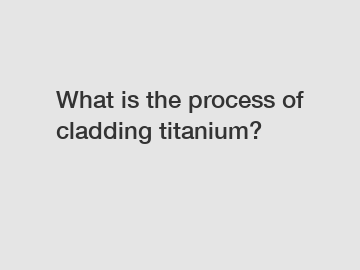What is the process of cladding titanium?
Titanium is a versatile and durable metal that is widely used in various industries due to its corrosion resistance, high strength-to-weight ratio, and biocompatibility. One popular process used to enhance the properties of titanium is cladding. Cladding is a technique where a layer of one metal is bonded to another to improve its surface properties or provide a protective coating. In the case of titanium, cladding can be used to increase its resistance to wear, corrosion, or temperature. .
Cladding titanium involves several steps and processes to ensure a strong bond between the base metal and the cladding material. From surface preparation to bonding techniques, each step plays a crucial role in the quality and performance of the clad titanium. In this article, we will discuss the process of cladding titanium in detail.
### Surface Preparation.

Before the cladding process begins, the surface of the titanium substrate must be cleaned thoroughly to remove any contaminants that could affect the bond between the metals. This is typically done through a combination of chemical cleaning, mechanical abrasion, and degreasing. The goal is to achieve a clean, oxide-free surface that promotes adhesion between the base metal and the cladding material.
### Selection of Cladding Material.
The choice of cladding material depends on the desired properties of the final product. Common materials used for cladding titanium include stainless steel, nickel alloys, and copper alloys. These materials offer different advantages such as improved corrosion resistance, enhanced mechanical properties, or increased wear resistance. The compatibility between the base metal and the cladding material is crucial to ensure a strong bond and a uniform coating.
### Bonding Techniques.
There are several methods used to bond the cladding material to the titanium substrate, including hot isostatic pressing (HIP), explosive welding, and laser cladding. Each technique has its own set of advantages and limitations, depending on factors such as the thickness of the cladding layer, the size of the components, and the required properties of the final product. Regardless of the bonding method used, the goal is to achieve a metallurgical bond between the base metal and the cladding material that ensures a uniform and durable coating.
### Quality Control.
Throughout the cladding process, quality control measures are essential to ensure the integrity and performance of the clad titanium. Non-destructive testing methods such as ultrasonic testing, radiography, and visual inspection are used to check for defects, porosity, or delamination in the clad layer. Any imperfections found during the quality control process must be addressed promptly to maintain the quality of the final product.
### Conclusion.
In conclusion, the process of cladding titanium is a complex and precise technique that involves several steps to achieve a strong bond between the base metal and the cladding material. From surface preparation to bonding techniques and quality control measures, each stage of the cladding process plays a crucial role in the performance and durability of the clad titanium. By following the proper procedures and using the right materials and methods, manufacturers can create high-quality clad titanium products for various applications.
If you are interested in learning more about the process of cladding titanium or if you have any questions about our cladding services, please feel free to contact us.
If you want to learn more, please visit our website colored stainless steel sheet suppliers, Stainless steel lining plate, Cladding jacketing.

